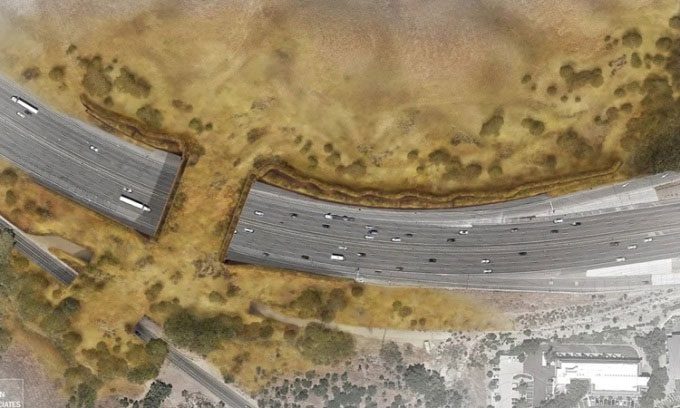The 64-meter-long bridge spanning an 8-lane highway in Los Angeles County is set to be completed by 2025.
This ambitious project in California aims to address the conflict between wildlife and humans, as over one million collisions between wild animals and vehicles occur annually across the United States, resulting in 200 fatalities and 26,000 injuries to drivers and passengers. Authorities are building the largest wildlife overpass in the world over Highway 101 in Los Angeles County, as reported by Smithsonian on April 24.

Aerial view of the wildlife overpass. (Photo: Rock Design Associates).
Once completed in 2025, this artificial bridge will provide a safe passage for mountain lions, bobcats, deer, lizards, coyotes, snakes, and ants to move between the Santa Monica Mountains and the Simi Hills of the Santa Susana Mountains. Named the Wallis Annenberg Wildlife Crossing, the project has a budget of $92 million, funded through collaboration among various entities including Caltrans, the National Park Service, and the National Wildlife Federation.
The groundbreaking took place exactly two years ago on Earth Day. Last week, the project reached a significant milestone when the first section of the bridge was positioned above the highway. In the coming months, the construction team will install more concrete beams, each weighing between 126 and 140 tons. The 64-meter-long overpass will span above eight lanes of traffic. Ultimately, the structure will be covered with vegetation, including over a million native plants, to attract wildlife. The construction team will also plant trees on nearly 5 hectares on both sides of the overpass to create a more natural hillside experience rather than a bridge.
While the bridge will provide numerous benefits for wildlife, experts particularly hope that the project will improve the lives of mountain lions. In the wild, they typically roam territories spanning nearly 260 square kilometers. However, due to the numerous highways in Los Angeles, they face challenges in moving freely. As a result, mountain lions in some areas are breeding with close relatives, which increases their susceptibility to various health issues. This large cat species may disappear from the region if genetic diversity does not improve.
In recent years, the story of a famous mountain lion named P-22 has garnered significant attention. Born in 2010, P-22 had to cross at least two heavily trafficked highways to reach its home in Griffith Park in Los Angeles. It spent over a decade wandering through a small isolated territory with little hope of finding a mate. In December 2022, authorities had to euthanize P-22 after it attacked two pet dogs. Subsequent examinations revealed it had multiple injuries from vehicle strikes, a fractured skull, kidney disease, arthritis, and several other chronic conditions. Its story has inspired many individuals and organizations to contribute to the Wallis Annenberg Wildlife Crossing project.




















































